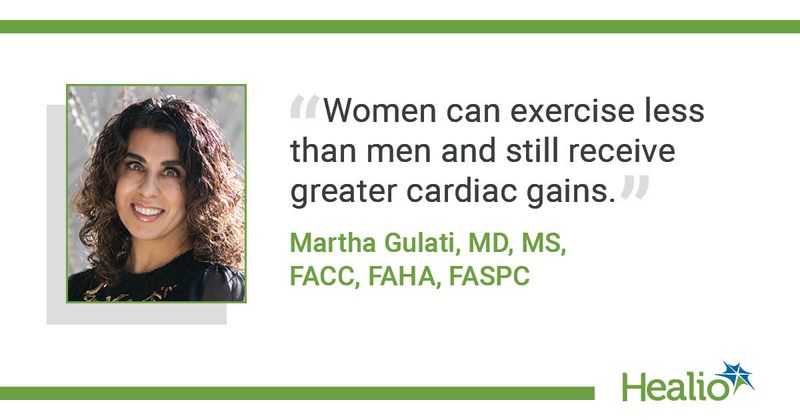Women may experience greater mortality gains with physical activity than men
Key takeaways:
- Data show women live longer than men when reporting similar amounts of moderate to vigorous physical activity.
- The data suggest sex-specific benefits to exercise.
Compared with men, women are less likely to die of any cause or from CV-specific causes when performing similar amounts of weekly leisure-time physical activity, suggesting there are sex-specific benefits to exercise, researchers reported.
The study, an analysis of participant-reported physical activity data from more than 400,000 U.S. adults linked to death records data, show that both sexes achieved a peak survival benefit at 300 minutes of weekly aerobic physical activity; however, women derived a 24% mortality reduction while men derived an 18% mortality reduction from the same degree of regular exercise.

“Any time recommendations are the same for men and women, it begs the question: Should they be?” Martha Gulati, MD, MS, FACC, FAHA, FASPC, associate director of the Barbra Streisand Women’s Heart Center, director of preventive cardiology at the Smidt Heart Institute at Cedars-Sinai and president of the American Society for Preventive Cardiology, told Healio. “What are those [physical activity] recommendations based on? Is there evidence; is there data? Many times, assumptions are made and there are no data specific to women.”
Assessing physical activity and death data
In the prospective study, published in the Journal of the American College of Cardiology, Gulati and colleagues analyzed data from 412,413 U.S. adults who had no preexisting CVD and no limitations on activities of daily living and who provided survey data on leisure-time physical activity as part of the CDC’s National Health Interview Survey. The mean age of participants was 44 years, 54.7% were women, 14.4% identified as Black and 18.4% identified as Hispanic. The frequency of participant-reported activities (times per week) was multiplied by duration of the activity to provide the minutes per week of aerobic physical activity.
“To account for intensity, total weighted moderate to vigorous intensity aerobic physical activity (MVPA) was obtained by summing the duration of moderate intensity plus vigorous intensity multiplied by 2,” the researchers wrote.
Researchers examined sex-specific associations of physical activity measures (frequency, duration, intensity, type) with all-cause and CV mortality from 1997 to 2019.
During 4,911,178 person-years of follow-up, there were 39,935 all-cause deaths including 11,670 CV deaths. Overall, 32.5% of women and 43.1% of men regularly engaged in aerobic physical activity. However, all major measures of physical activity were more frequent in men, with regular engagement rates in moderate physical activity of 10.3% and 15.2% for women and men, respectively, and rates of vigorous physical activity of 28.3% and 38.9% for women and men, respectively.
Compared with inactivity, leisure-time physical activity was associated with a 24% lower risk for all-cause mortality for women (HR = 0.76; 95% CI, 0.73-0.8) and 15% lower risk for all-cause mortality for men (HR = 0.85; 95% CI, 0.82-0.89; Wald test, F = 12; P for interaction < .001).
Men reached their maximal survival benefit of an HR of 0.81 from 300 minutes per week of MVPA, whereas women achieved a similar benefit at 140 minutes per week, and then continued to reach a maximum survival benefit of an HR of 0.76 at 300 minutes per week, according to the researchers.
Sex-specific findings were similar for CV death (Wald test, F = 20.1; P for interaction < .001) and were consistent across all measures of aerobic activity as well as muscle strengthening activity (Wald test, F = 6.7; P for interaction = .009).
“We hypothesize that there are differences in response to exercise for men vs. women, even as we already knew there are sex differences in fitness,” Gulati said during an interview. “Women do tend to have a lower exercise capacity but then gain at least as much benefit, if not more, compared with men. Additionally, we know there are different muscle fiber types that are disproportionately more present in women compared with men. Those muscle fibers may respond differently to strength training. Women also have less muscle than men and tend to carry more body fat than men, on average. There may be something related to the efficiency of exercise and improving both muscle strength and cardiorespiratory fitness in women.”
Gulati said the data suggest clinicians should consider more tailored recommendations of physical activity and consider not adhering too tightly to guidelines for select patients, particularly those who are sedentary.
“Women can exercise less than men and still receive greater cardiac gains,” Gulati said. “This is not to say that I do not want women to exercise; absolutely not true. But, sometimes when we are with our patients and we talk about these guidelines — do 150 minutes of exercise per week — many patients leave and do nothing. It is daunting and they leave and say, ‘That is not happening.’ We have to reframe exercise. There was an incremental benefit with exercise until hitting that 300 minutes per week mark. We should be ‘dosing’ exercise or physical activity in a way that makes sense for our patients.”
Sex-specific benefits with exercise
In a related editorial published in the Journal of the American College of Cardiology, Wael A. Jaber, MD, and Erika Hutt, MD, both from the section of cardiac imaging in the department of cardiovascular medicine at Cleveland Clinic, wrote that the sex-specific benefit shown in women has the potential to influence sex-specific exercise recommendations in major societal guidelines.
“This may encourage physically inactive women to engage more in leisure-time physical activity given a more achievable goal in those women who believe that time is a barrier to exercise,” Jaber and Hutt wrote. “In addition, it may motivate physically active women to increase their exercise engagement given the substantial reduction in all-cause mortality and cardiovascular mortality of up to 24%.”
Reference:
For more information:
Martha Gulati, MD, MS, FACC, FAHA, FASPC, can be reached at martha.gulati@csmc.edu.
